Indigenous ENGAGEMENT IN RESOURCE MANAGEMENT 7 7 Indigenous engagement in natural and cultural resource management
VerifiedAdded on 2022/10/11
|8
|2194
|10
Assignment
AI Summary
Contribute Materials
Your contribution can guide someone’s learning journey. Share your
documents today.
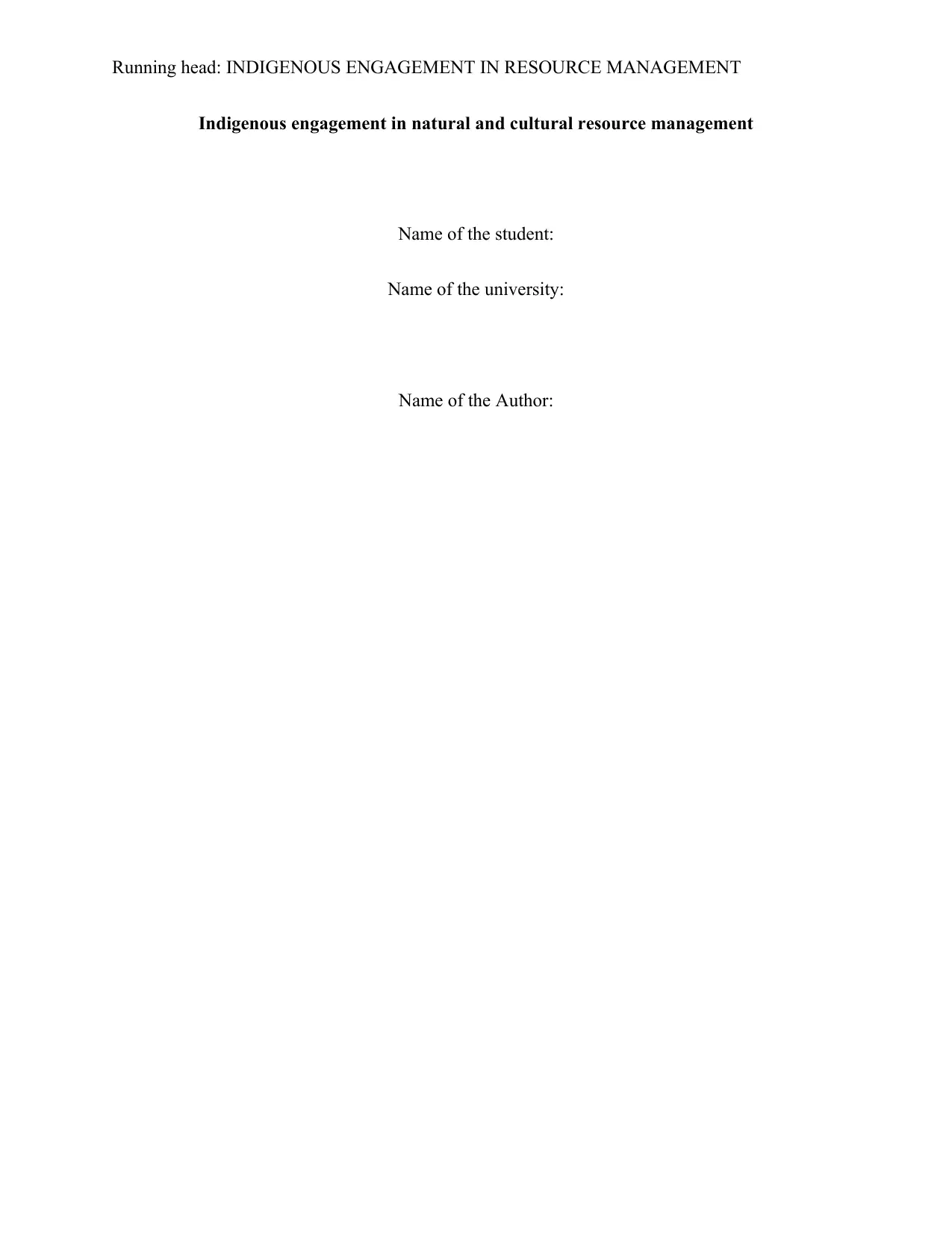
Running head: INDIGENOUS ENGAGEMENT IN RESOURCE MANAGEMENT
Indigenous engagement in natural and cultural resource management
Name of the student:
Name of the university:
Name of the Author:
Indigenous engagement in natural and cultural resource management
Name of the student:
Name of the university:
Name of the Author:
Secure Best Marks with AI Grader
Need help grading? Try our AI Grader for instant feedback on your assignments.
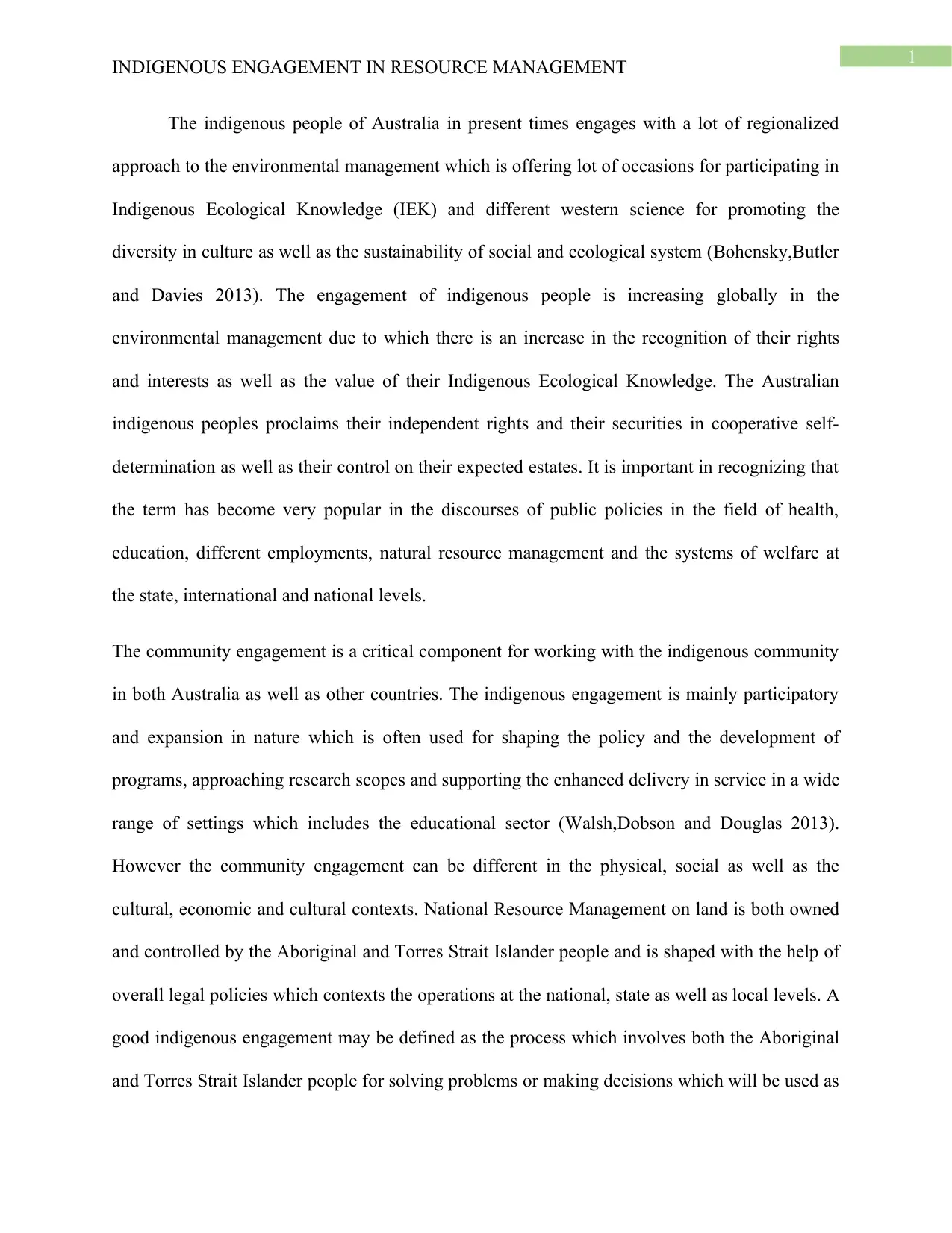
1
INDIGENOUS ENGAGEMENT IN RESOURCE MANAGEMENT
The indigenous people of Australia in present times engages with a lot of regionalized
approach to the environmental management which is offering lot of occasions for participating in
Indigenous Ecological Knowledge (IEK) and different western science for promoting the
diversity in culture as well as the sustainability of social and ecological system (Bohensky,Butler
and Davies 2013). The engagement of indigenous people is increasing globally in the
environmental management due to which there is an increase in the recognition of their rights
and interests as well as the value of their Indigenous Ecological Knowledge. The Australian
indigenous peoples proclaims their independent rights and their securities in cooperative self-
determination as well as their control on their expected estates. It is important in recognizing that
the term has become very popular in the discourses of public policies in the field of health,
education, different employments, natural resource management and the systems of welfare at
the state, international and national levels.
The community engagement is a critical component for working with the indigenous community
in both Australia as well as other countries. The indigenous engagement is mainly participatory
and expansion in nature which is often used for shaping the policy and the development of
programs, approaching research scopes and supporting the enhanced delivery in service in a wide
range of settings which includes the educational sector (Walsh,Dobson and Douglas 2013).
However the community engagement can be different in the physical, social as well as the
cultural, economic and cultural contexts. National Resource Management on land is both owned
and controlled by the Aboriginal and Torres Strait Islander people and is shaped with the help of
overall legal policies which contexts the operations at the national, state as well as local levels. A
good indigenous engagement may be defined as the process which involves both the Aboriginal
and Torres Strait Islander people for solving problems or making decisions which will be used as
INDIGENOUS ENGAGEMENT IN RESOURCE MANAGEMENT
The indigenous people of Australia in present times engages with a lot of regionalized
approach to the environmental management which is offering lot of occasions for participating in
Indigenous Ecological Knowledge (IEK) and different western science for promoting the
diversity in culture as well as the sustainability of social and ecological system (Bohensky,Butler
and Davies 2013). The engagement of indigenous people is increasing globally in the
environmental management due to which there is an increase in the recognition of their rights
and interests as well as the value of their Indigenous Ecological Knowledge. The Australian
indigenous peoples proclaims their independent rights and their securities in cooperative self-
determination as well as their control on their expected estates. It is important in recognizing that
the term has become very popular in the discourses of public policies in the field of health,
education, different employments, natural resource management and the systems of welfare at
the state, international and national levels.
The community engagement is a critical component for working with the indigenous community
in both Australia as well as other countries. The indigenous engagement is mainly participatory
and expansion in nature which is often used for shaping the policy and the development of
programs, approaching research scopes and supporting the enhanced delivery in service in a wide
range of settings which includes the educational sector (Walsh,Dobson and Douglas 2013).
However the community engagement can be different in the physical, social as well as the
cultural, economic and cultural contexts. National Resource Management on land is both owned
and controlled by the Aboriginal and Torres Strait Islander people and is shaped with the help of
overall legal policies which contexts the operations at the national, state as well as local levels. A
good indigenous engagement may be defined as the process which involves both the Aboriginal
and Torres Strait Islander people for solving problems or making decisions which will be used as
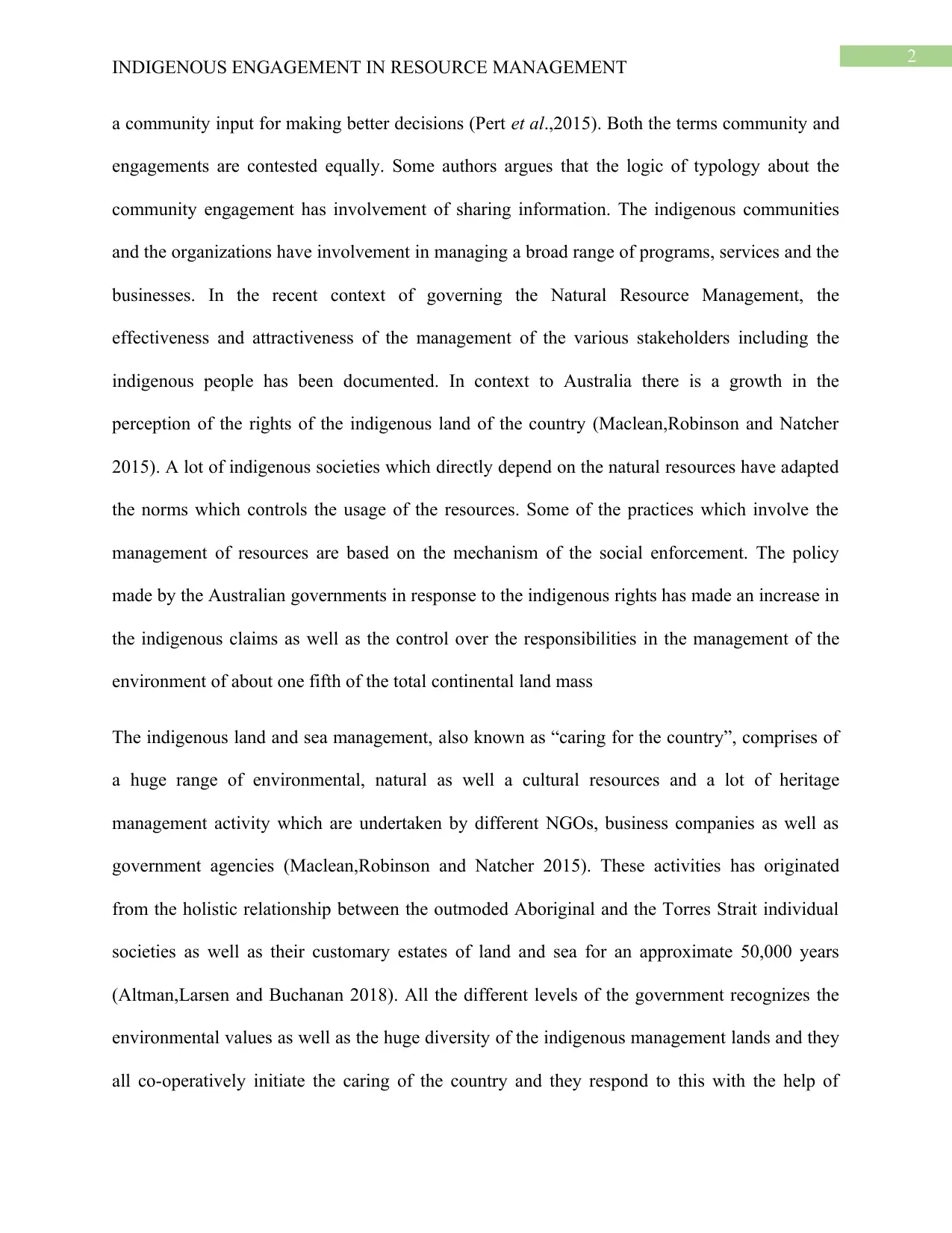
2
INDIGENOUS ENGAGEMENT IN RESOURCE MANAGEMENT
a community input for making better decisions (Pert et al.,2015). Both the terms community and
engagements are contested equally. Some authors argues that the logic of typology about the
community engagement has involvement of sharing information. The indigenous communities
and the organizations have involvement in managing a broad range of programs, services and the
businesses. In the recent context of governing the Natural Resource Management, the
effectiveness and attractiveness of the management of the various stakeholders including the
indigenous people has been documented. In context to Australia there is a growth in the
perception of the rights of the indigenous land of the country (Maclean,Robinson and Natcher
2015). A lot of indigenous societies which directly depend on the natural resources have adapted
the norms which controls the usage of the resources. Some of the practices which involve the
management of resources are based on the mechanism of the social enforcement. The policy
made by the Australian governments in response to the indigenous rights has made an increase in
the indigenous claims as well as the control over the responsibilities in the management of the
environment of about one fifth of the total continental land mass
The indigenous land and sea management, also known as “caring for the country”, comprises of
a huge range of environmental, natural as well a cultural resources and a lot of heritage
management activity which are undertaken by different NGOs, business companies as well as
government agencies (Maclean,Robinson and Natcher 2015). These activities has originated
from the holistic relationship between the outmoded Aboriginal and the Torres Strait individual
societies as well as their customary estates of land and sea for an approximate 50,000 years
(Altman,Larsen and Buchanan 2018). All the different levels of the government recognizes the
environmental values as well as the huge diversity of the indigenous management lands and they
all co-operatively initiate the caring of the country and they respond to this with the help of
INDIGENOUS ENGAGEMENT IN RESOURCE MANAGEMENT
a community input for making better decisions (Pert et al.,2015). Both the terms community and
engagements are contested equally. Some authors argues that the logic of typology about the
community engagement has involvement of sharing information. The indigenous communities
and the organizations have involvement in managing a broad range of programs, services and the
businesses. In the recent context of governing the Natural Resource Management, the
effectiveness and attractiveness of the management of the various stakeholders including the
indigenous people has been documented. In context to Australia there is a growth in the
perception of the rights of the indigenous land of the country (Maclean,Robinson and Natcher
2015). A lot of indigenous societies which directly depend on the natural resources have adapted
the norms which controls the usage of the resources. Some of the practices which involve the
management of resources are based on the mechanism of the social enforcement. The policy
made by the Australian governments in response to the indigenous rights has made an increase in
the indigenous claims as well as the control over the responsibilities in the management of the
environment of about one fifth of the total continental land mass
The indigenous land and sea management, also known as “caring for the country”, comprises of
a huge range of environmental, natural as well a cultural resources and a lot of heritage
management activity which are undertaken by different NGOs, business companies as well as
government agencies (Maclean,Robinson and Natcher 2015). These activities has originated
from the holistic relationship between the outmoded Aboriginal and the Torres Strait individual
societies as well as their customary estates of land and sea for an approximate 50,000 years
(Altman,Larsen and Buchanan 2018). All the different levels of the government recognizes the
environmental values as well as the huge diversity of the indigenous management lands and they
all co-operatively initiate the caring of the country and they respond to this with the help of
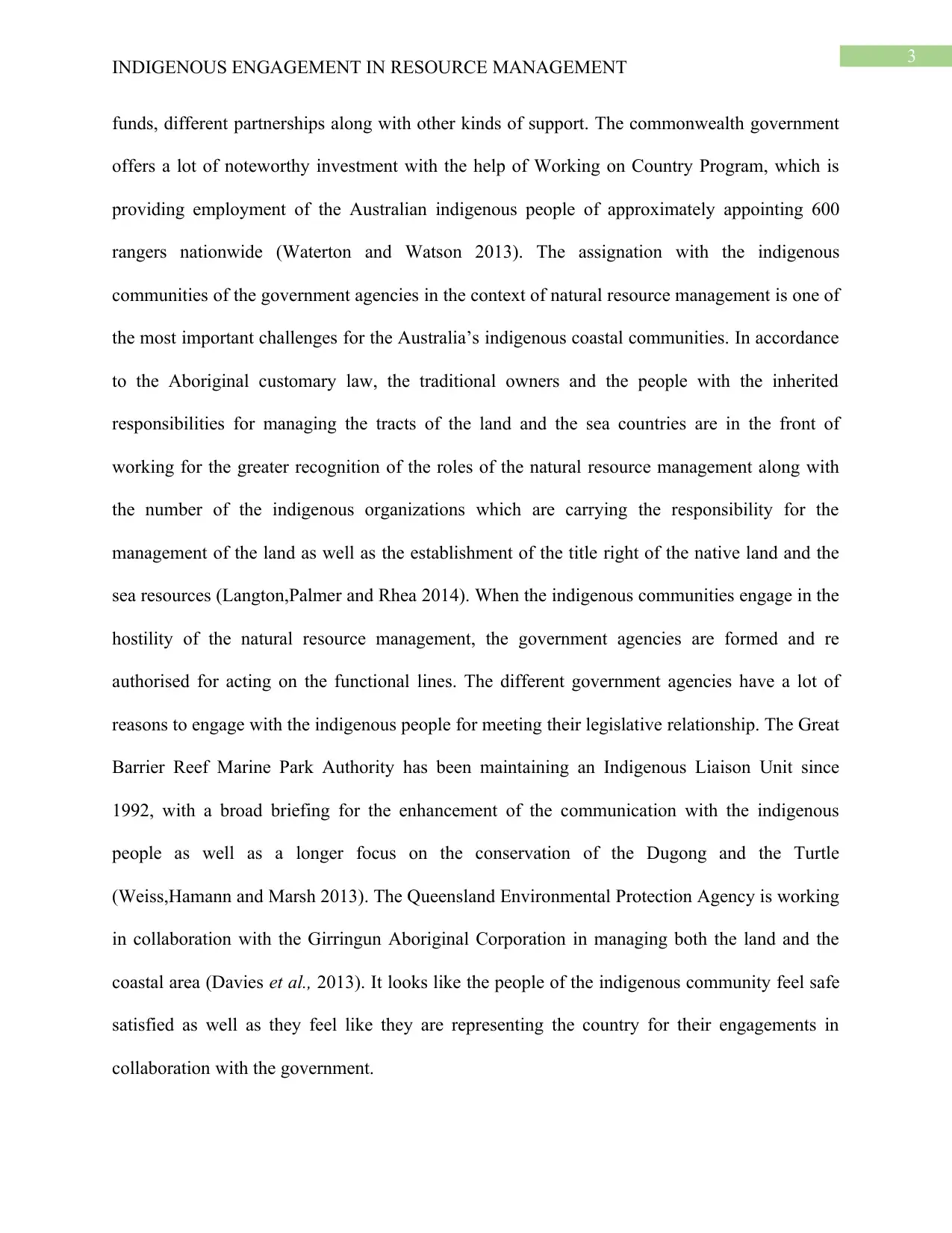
3
INDIGENOUS ENGAGEMENT IN RESOURCE MANAGEMENT
funds, different partnerships along with other kinds of support. The commonwealth government
offers a lot of noteworthy investment with the help of Working on Country Program, which is
providing employment of the Australian indigenous people of approximately appointing 600
rangers nationwide (Waterton and Watson 2013). The assignation with the indigenous
communities of the government agencies in the context of natural resource management is one of
the most important challenges for the Australia’s indigenous coastal communities. In accordance
to the Aboriginal customary law, the traditional owners and the people with the inherited
responsibilities for managing the tracts of the land and the sea countries are in the front of
working for the greater recognition of the roles of the natural resource management along with
the number of the indigenous organizations which are carrying the responsibility for the
management of the land as well as the establishment of the title right of the native land and the
sea resources (Langton,Palmer and Rhea 2014). When the indigenous communities engage in the
hostility of the natural resource management, the government agencies are formed and re
authorised for acting on the functional lines. The different government agencies have a lot of
reasons to engage with the indigenous people for meeting their legislative relationship. The Great
Barrier Reef Marine Park Authority has been maintaining an Indigenous Liaison Unit since
1992, with a broad briefing for the enhancement of the communication with the indigenous
people as well as a longer focus on the conservation of the Dugong and the Turtle
(Weiss,Hamann and Marsh 2013). The Queensland Environmental Protection Agency is working
in collaboration with the Girringun Aboriginal Corporation in managing both the land and the
coastal area (Davies et al., 2013). It looks like the people of the indigenous community feel safe
satisfied as well as they feel like they are representing the country for their engagements in
collaboration with the government.
INDIGENOUS ENGAGEMENT IN RESOURCE MANAGEMENT
funds, different partnerships along with other kinds of support. The commonwealth government
offers a lot of noteworthy investment with the help of Working on Country Program, which is
providing employment of the Australian indigenous people of approximately appointing 600
rangers nationwide (Waterton and Watson 2013). The assignation with the indigenous
communities of the government agencies in the context of natural resource management is one of
the most important challenges for the Australia’s indigenous coastal communities. In accordance
to the Aboriginal customary law, the traditional owners and the people with the inherited
responsibilities for managing the tracts of the land and the sea countries are in the front of
working for the greater recognition of the roles of the natural resource management along with
the number of the indigenous organizations which are carrying the responsibility for the
management of the land as well as the establishment of the title right of the native land and the
sea resources (Langton,Palmer and Rhea 2014). When the indigenous communities engage in the
hostility of the natural resource management, the government agencies are formed and re
authorised for acting on the functional lines. The different government agencies have a lot of
reasons to engage with the indigenous people for meeting their legislative relationship. The Great
Barrier Reef Marine Park Authority has been maintaining an Indigenous Liaison Unit since
1992, with a broad briefing for the enhancement of the communication with the indigenous
people as well as a longer focus on the conservation of the Dugong and the Turtle
(Weiss,Hamann and Marsh 2013). The Queensland Environmental Protection Agency is working
in collaboration with the Girringun Aboriginal Corporation in managing both the land and the
coastal area (Davies et al., 2013). It looks like the people of the indigenous community feel safe
satisfied as well as they feel like they are representing the country for their engagements in
collaboration with the government.
Secure Best Marks with AI Grader
Need help grading? Try our AI Grader for instant feedback on your assignments.
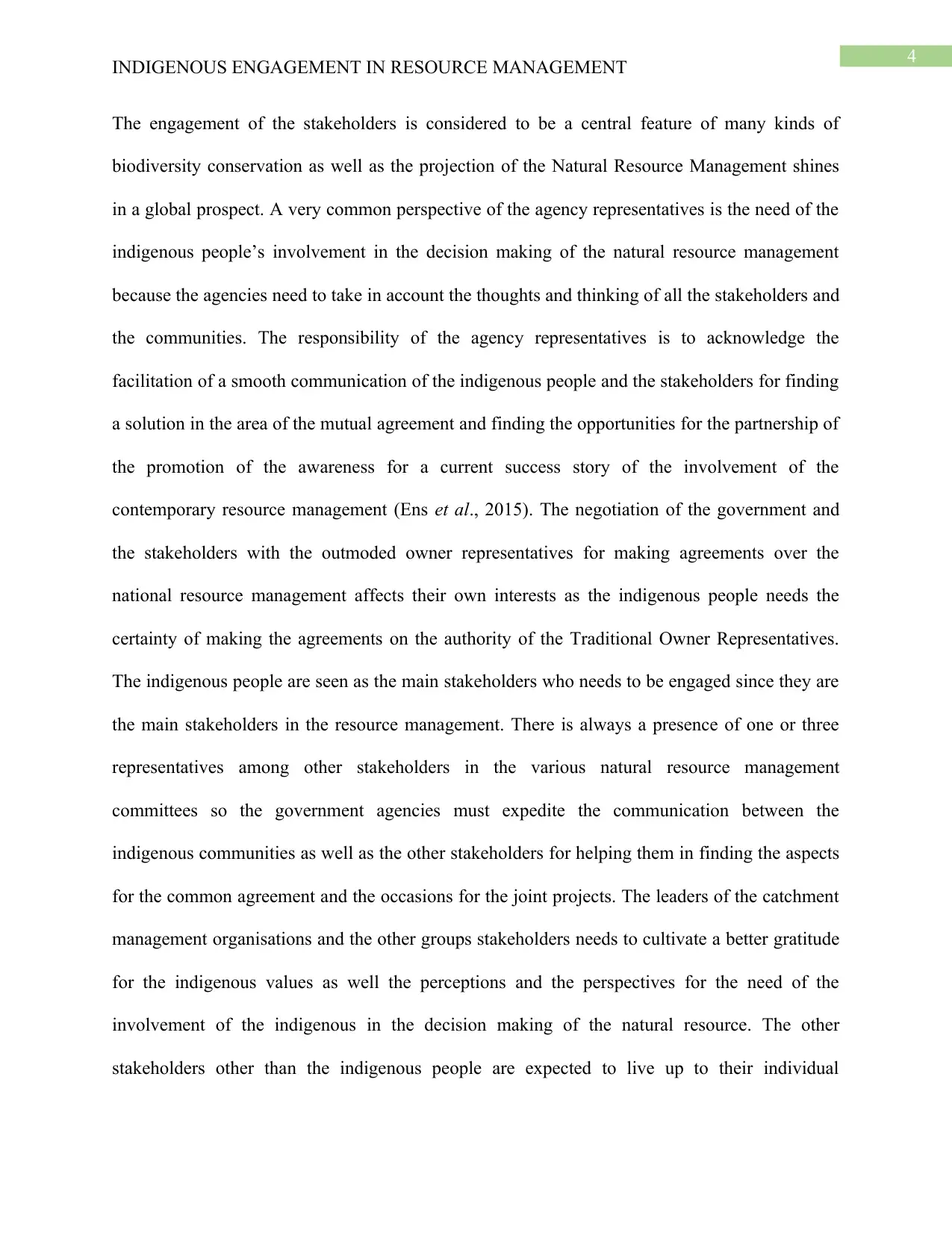
4
INDIGENOUS ENGAGEMENT IN RESOURCE MANAGEMENT
The engagement of the stakeholders is considered to be a central feature of many kinds of
biodiversity conservation as well as the projection of the Natural Resource Management shines
in a global prospect. A very common perspective of the agency representatives is the need of the
indigenous people’s involvement in the decision making of the natural resource management
because the agencies need to take in account the thoughts and thinking of all the stakeholders and
the communities. The responsibility of the agency representatives is to acknowledge the
facilitation of a smooth communication of the indigenous people and the stakeholders for finding
a solution in the area of the mutual agreement and finding the opportunities for the partnership of
the promotion of the awareness for a current success story of the involvement of the
contemporary resource management (Ens et al., 2015). The negotiation of the government and
the stakeholders with the outmoded owner representatives for making agreements over the
national resource management affects their own interests as the indigenous people needs the
certainty of making the agreements on the authority of the Traditional Owner Representatives.
The indigenous people are seen as the main stakeholders who needs to be engaged since they are
the main stakeholders in the resource management. There is always a presence of one or three
representatives among other stakeholders in the various natural resource management
committees so the government agencies must expedite the communication between the
indigenous communities as well as the other stakeholders for helping them in finding the aspects
for the common agreement and the occasions for the joint projects. The leaders of the catchment
management organisations and the other groups stakeholders needs to cultivate a better gratitude
for the indigenous values as well the perceptions and the perspectives for the need of the
involvement of the indigenous in the decision making of the natural resource. The other
stakeholders other than the indigenous people are expected to live up to their individual
INDIGENOUS ENGAGEMENT IN RESOURCE MANAGEMENT
The engagement of the stakeholders is considered to be a central feature of many kinds of
biodiversity conservation as well as the projection of the Natural Resource Management shines
in a global prospect. A very common perspective of the agency representatives is the need of the
indigenous people’s involvement in the decision making of the natural resource management
because the agencies need to take in account the thoughts and thinking of all the stakeholders and
the communities. The responsibility of the agency representatives is to acknowledge the
facilitation of a smooth communication of the indigenous people and the stakeholders for finding
a solution in the area of the mutual agreement and finding the opportunities for the partnership of
the promotion of the awareness for a current success story of the involvement of the
contemporary resource management (Ens et al., 2015). The negotiation of the government and
the stakeholders with the outmoded owner representatives for making agreements over the
national resource management affects their own interests as the indigenous people needs the
certainty of making the agreements on the authority of the Traditional Owner Representatives.
The indigenous people are seen as the main stakeholders who needs to be engaged since they are
the main stakeholders in the resource management. There is always a presence of one or three
representatives among other stakeholders in the various natural resource management
committees so the government agencies must expedite the communication between the
indigenous communities as well as the other stakeholders for helping them in finding the aspects
for the common agreement and the occasions for the joint projects. The leaders of the catchment
management organisations and the other groups stakeholders needs to cultivate a better gratitude
for the indigenous values as well the perceptions and the perspectives for the need of the
involvement of the indigenous in the decision making of the natural resource. The other
stakeholders other than the indigenous people are expected to live up to their individual
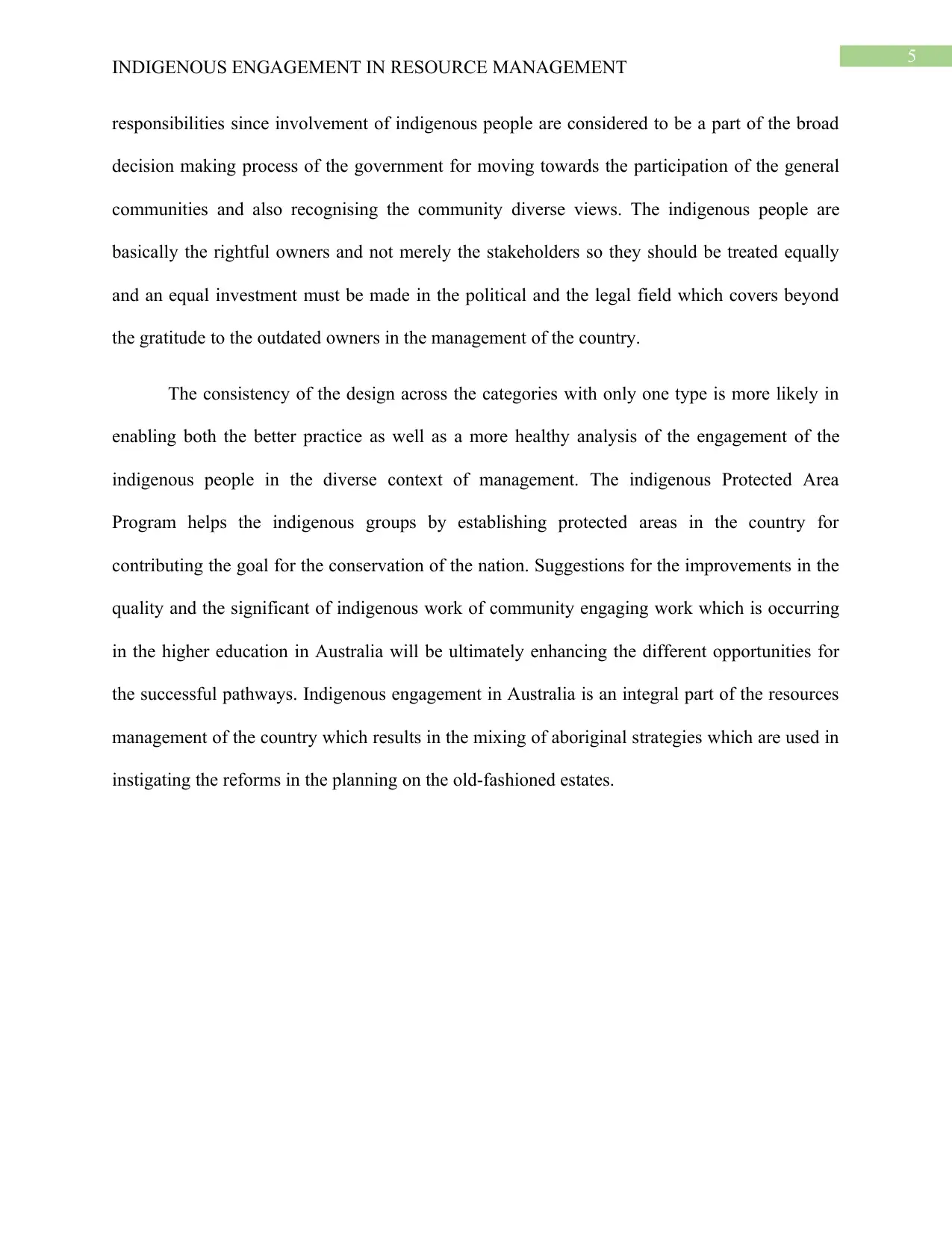
5
INDIGENOUS ENGAGEMENT IN RESOURCE MANAGEMENT
responsibilities since involvement of indigenous people are considered to be a part of the broad
decision making process of the government for moving towards the participation of the general
communities and also recognising the community diverse views. The indigenous people are
basically the rightful owners and not merely the stakeholders so they should be treated equally
and an equal investment must be made in the political and the legal field which covers beyond
the gratitude to the outdated owners in the management of the country.
The consistency of the design across the categories with only one type is more likely in
enabling both the better practice as well as a more healthy analysis of the engagement of the
indigenous people in the diverse context of management. The indigenous Protected Area
Program helps the indigenous groups by establishing protected areas in the country for
contributing the goal for the conservation of the nation. Suggestions for the improvements in the
quality and the significant of indigenous work of community engaging work which is occurring
in the higher education in Australia will be ultimately enhancing the different opportunities for
the successful pathways. Indigenous engagement in Australia is an integral part of the resources
management of the country which results in the mixing of aboriginal strategies which are used in
instigating the reforms in the planning on the old-fashioned estates.
INDIGENOUS ENGAGEMENT IN RESOURCE MANAGEMENT
responsibilities since involvement of indigenous people are considered to be a part of the broad
decision making process of the government for moving towards the participation of the general
communities and also recognising the community diverse views. The indigenous people are
basically the rightful owners and not merely the stakeholders so they should be treated equally
and an equal investment must be made in the political and the legal field which covers beyond
the gratitude to the outdated owners in the management of the country.
The consistency of the design across the categories with only one type is more likely in
enabling both the better practice as well as a more healthy analysis of the engagement of the
indigenous people in the diverse context of management. The indigenous Protected Area
Program helps the indigenous groups by establishing protected areas in the country for
contributing the goal for the conservation of the nation. Suggestions for the improvements in the
quality and the significant of indigenous work of community engaging work which is occurring
in the higher education in Australia will be ultimately enhancing the different opportunities for
the successful pathways. Indigenous engagement in Australia is an integral part of the resources
management of the country which results in the mixing of aboriginal strategies which are used in
instigating the reforms in the planning on the old-fashioned estates.
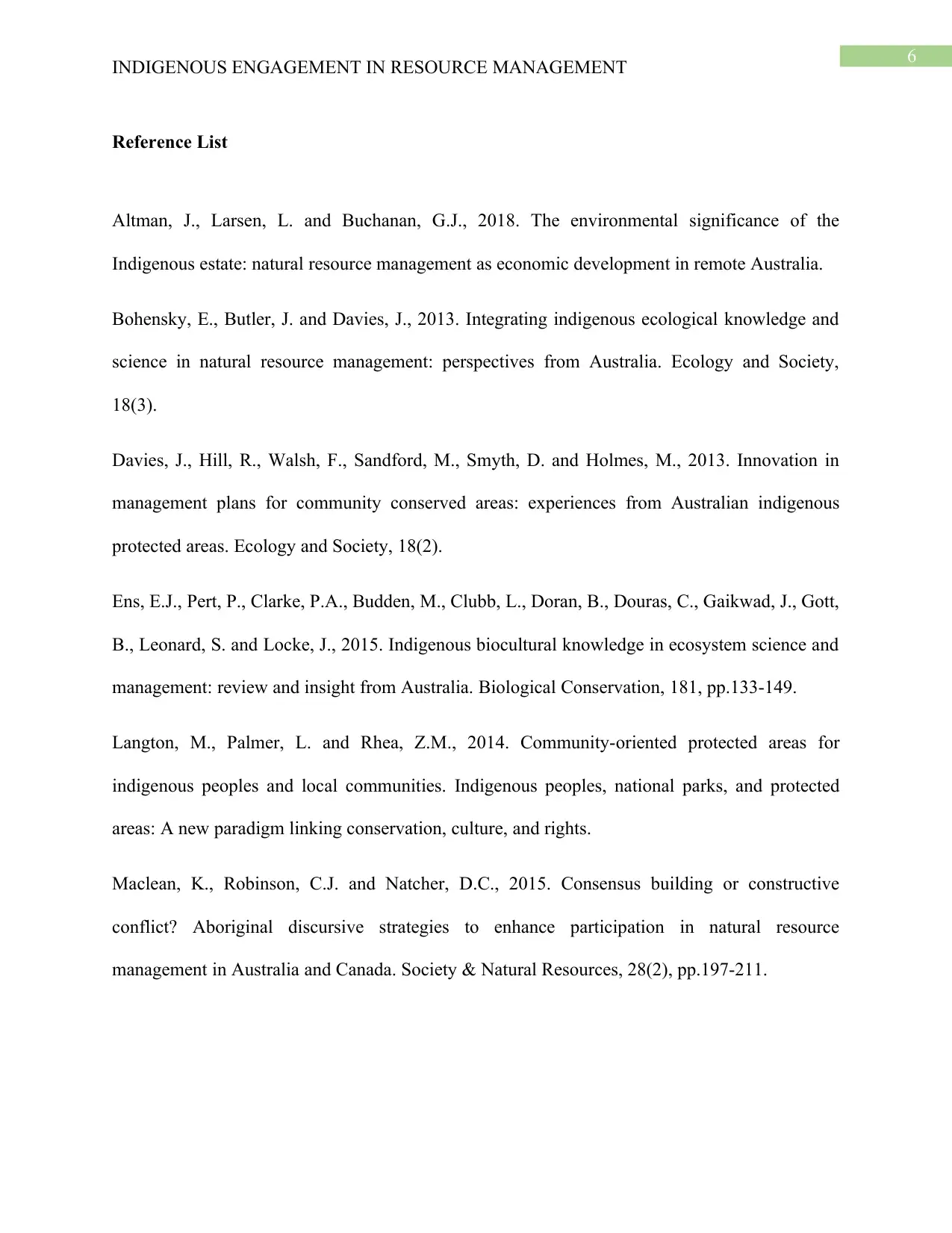
6
INDIGENOUS ENGAGEMENT IN RESOURCE MANAGEMENT
Reference List
Altman, J., Larsen, L. and Buchanan, G.J., 2018. The environmental significance of the
Indigenous estate: natural resource management as economic development in remote Australia.
Bohensky, E., Butler, J. and Davies, J., 2013. Integrating indigenous ecological knowledge and
science in natural resource management: perspectives from Australia. Ecology and Society,
18(3).
Davies, J., Hill, R., Walsh, F., Sandford, M., Smyth, D. and Holmes, M., 2013. Innovation in
management plans for community conserved areas: experiences from Australian indigenous
protected areas. Ecology and Society, 18(2).
Ens, E.J., Pert, P., Clarke, P.A., Budden, M., Clubb, L., Doran, B., Douras, C., Gaikwad, J., Gott,
B., Leonard, S. and Locke, J., 2015. Indigenous biocultural knowledge in ecosystem science and
management: review and insight from Australia. Biological Conservation, 181, pp.133-149.
Langton, M., Palmer, L. and Rhea, Z.M., 2014. Community-oriented protected areas for
indigenous peoples and local communities. Indigenous peoples, national parks, and protected
areas: A new paradigm linking conservation, culture, and rights.
Maclean, K., Robinson, C.J. and Natcher, D.C., 2015. Consensus building or constructive
conflict? Aboriginal discursive strategies to enhance participation in natural resource
management in Australia and Canada. Society & Natural Resources, 28(2), pp.197-211.
INDIGENOUS ENGAGEMENT IN RESOURCE MANAGEMENT
Reference List
Altman, J., Larsen, L. and Buchanan, G.J., 2018. The environmental significance of the
Indigenous estate: natural resource management as economic development in remote Australia.
Bohensky, E., Butler, J. and Davies, J., 2013. Integrating indigenous ecological knowledge and
science in natural resource management: perspectives from Australia. Ecology and Society,
18(3).
Davies, J., Hill, R., Walsh, F., Sandford, M., Smyth, D. and Holmes, M., 2013. Innovation in
management plans for community conserved areas: experiences from Australian indigenous
protected areas. Ecology and Society, 18(2).
Ens, E.J., Pert, P., Clarke, P.A., Budden, M., Clubb, L., Doran, B., Douras, C., Gaikwad, J., Gott,
B., Leonard, S. and Locke, J., 2015. Indigenous biocultural knowledge in ecosystem science and
management: review and insight from Australia. Biological Conservation, 181, pp.133-149.
Langton, M., Palmer, L. and Rhea, Z.M., 2014. Community-oriented protected areas for
indigenous peoples and local communities. Indigenous peoples, national parks, and protected
areas: A new paradigm linking conservation, culture, and rights.
Maclean, K., Robinson, C.J. and Natcher, D.C., 2015. Consensus building or constructive
conflict? Aboriginal discursive strategies to enhance participation in natural resource
management in Australia and Canada. Society & Natural Resources, 28(2), pp.197-211.
Paraphrase This Document
Need a fresh take? Get an instant paraphrase of this document with our AI Paraphraser
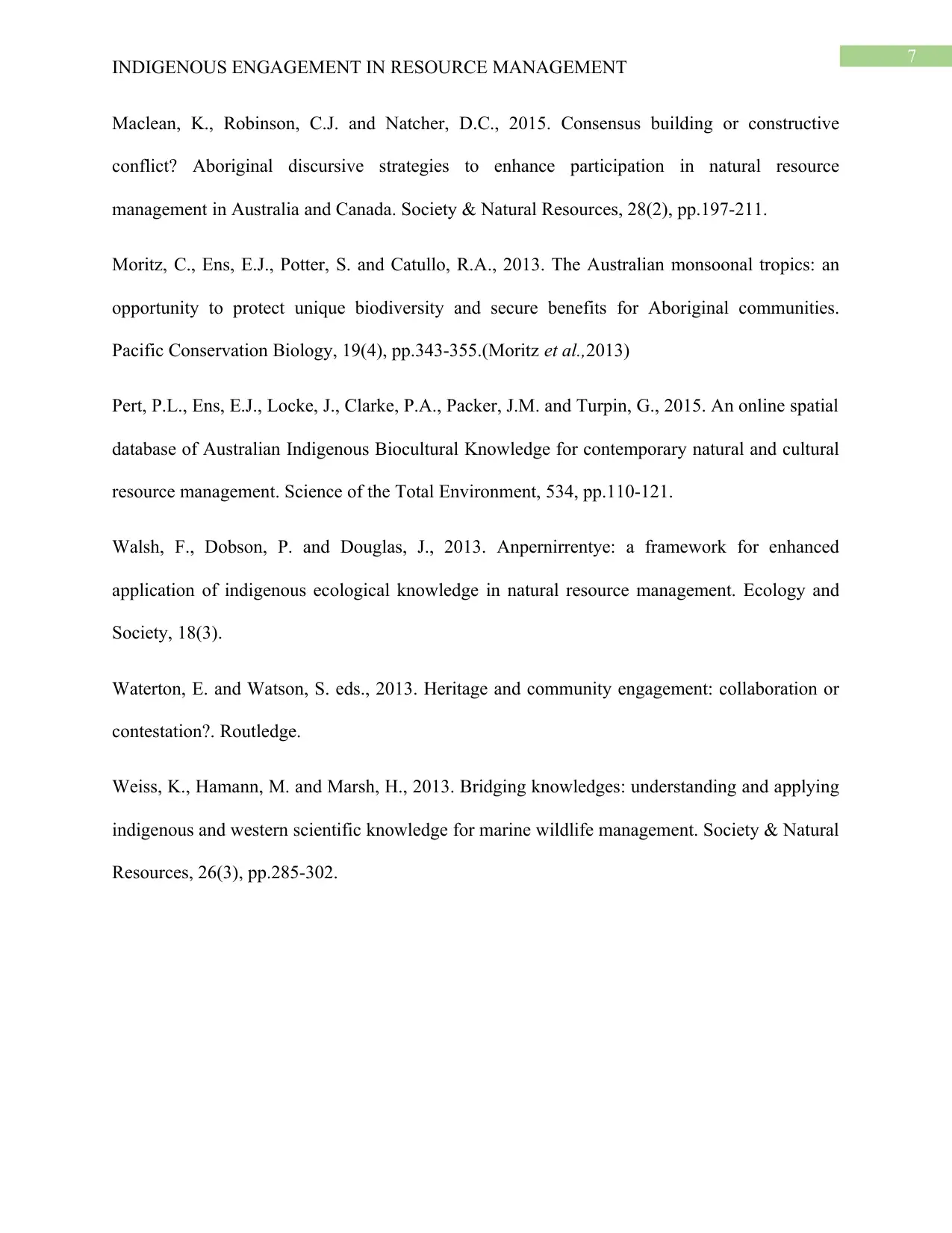
7
INDIGENOUS ENGAGEMENT IN RESOURCE MANAGEMENT
Maclean, K., Robinson, C.J. and Natcher, D.C., 2015. Consensus building or constructive
conflict? Aboriginal discursive strategies to enhance participation in natural resource
management in Australia and Canada. Society & Natural Resources, 28(2), pp.197-211.
Moritz, C., Ens, E.J., Potter, S. and Catullo, R.A., 2013. The Australian monsoonal tropics: an
opportunity to protect unique biodiversity and secure benefits for Aboriginal communities.
Pacific Conservation Biology, 19(4), pp.343-355.(Moritz et al.,2013)
Pert, P.L., Ens, E.J., Locke, J., Clarke, P.A., Packer, J.M. and Turpin, G., 2015. An online spatial
database of Australian Indigenous Biocultural Knowledge for contemporary natural and cultural
resource management. Science of the Total Environment, 534, pp.110-121.
Walsh, F., Dobson, P. and Douglas, J., 2013. Anpernirrentye: a framework for enhanced
application of indigenous ecological knowledge in natural resource management. Ecology and
Society, 18(3).
Waterton, E. and Watson, S. eds., 2013. Heritage and community engagement: collaboration or
contestation?. Routledge.
Weiss, K., Hamann, M. and Marsh, H., 2013. Bridging knowledges: understanding and applying
indigenous and western scientific knowledge for marine wildlife management. Society & Natural
Resources, 26(3), pp.285-302.
INDIGENOUS ENGAGEMENT IN RESOURCE MANAGEMENT
Maclean, K., Robinson, C.J. and Natcher, D.C., 2015. Consensus building or constructive
conflict? Aboriginal discursive strategies to enhance participation in natural resource
management in Australia and Canada. Society & Natural Resources, 28(2), pp.197-211.
Moritz, C., Ens, E.J., Potter, S. and Catullo, R.A., 2013. The Australian monsoonal tropics: an
opportunity to protect unique biodiversity and secure benefits for Aboriginal communities.
Pacific Conservation Biology, 19(4), pp.343-355.(Moritz et al.,2013)
Pert, P.L., Ens, E.J., Locke, J., Clarke, P.A., Packer, J.M. and Turpin, G., 2015. An online spatial
database of Australian Indigenous Biocultural Knowledge for contemporary natural and cultural
resource management. Science of the Total Environment, 534, pp.110-121.
Walsh, F., Dobson, P. and Douglas, J., 2013. Anpernirrentye: a framework for enhanced
application of indigenous ecological knowledge in natural resource management. Ecology and
Society, 18(3).
Waterton, E. and Watson, S. eds., 2013. Heritage and community engagement: collaboration or
contestation?. Routledge.
Weiss, K., Hamann, M. and Marsh, H., 2013. Bridging knowledges: understanding and applying
indigenous and western scientific knowledge for marine wildlife management. Society & Natural
Resources, 26(3), pp.285-302.
1 out of 8
Related Documents
Your All-in-One AI-Powered Toolkit for Academic Success.
+13062052269
info@desklib.com
Available 24*7 on WhatsApp / Email
![[object Object]](/_next/static/media/star-bottom.7253800d.svg)
Unlock your academic potential
© 2024 | Zucol Services PVT LTD | All rights reserved.





